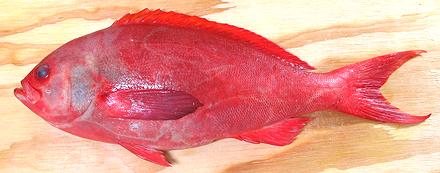 [Pristipomoides macrophthalmus]
[Pristipomoides macrophthalmus]
This true Snapper is found all around the Caribbean, from Yucatan along the north coast of South America, off the tip of Florida and along the Caribbean island chain. It can get up to 20 inches long, but the photo specimen was 15-3/4 inches long and weighed 1 pound 15-1/4 ounces, a bit larger than average market size. This snapper is an excellent eating fish, but at my local Philippine fish market it was selling at 2013 US $2.99/pound, while the better known "True Red Snapper" was selling at $6.99/pound. Cardinal Snapper is IUCN rated NE (Not Evaluated) and is not considered threatened.
More on Snapper Family.
This is a really excellent eating fish. The flesh is mild, but with good flavor, and tender. It is all white except for a thin darker layer just under the skin, but that layer does not have a strong flavor. Rather than breaking up into neat flakes, this fish tends to just break up, giving little priority to flake seams.
Skin-off fillets can be poached successfully or be given a short steaming, but more severe wet cooking will cause the tender flesh to fall apart. My favorite way to prepare this fish is to dust it with sweet potato or rice flour (batter or heavy flower would mask the fish's delicate taste), pan fry it, and eat it with a very light sauce, but I also often poach the fillets.
Buying: Here in Southern California, this fish is not common (things may be different in the Caribbean). I have found them occasionally in fish markets serving a Philippine community.
Scales: This fish is covered with a zillion smallish scales that are not hard to scrape off, but the do fly around a bit.
Cleaning: No particular problems in cleaning except that there's a lot of stuff in there, and some membranes are a bit difficult to pull out. The gills pull out with only moderate force.
Fillet: This is a very easy fish to fillet with easy to follow bone structure. There should be almost no flesh left behind. I usually remove the head before filleting. Tilt the knife to get under the gill covers to get as much flesh as possible. There will be a couple small bones you'll need to cut with kitchen shears, and then the backbone.
Make a cut on each side of the anal fin from tail to body cavity. From the head end to the tail, cut downward to the backbone, then over the backbone at the tail and work forward. When ;you get to the rib cage, just cut the ribs from the backbone with kitchen shears and pull them from the fillet with long nose pliers - they don't pull easily and tend to break up, but that's still the best strategy. There are a couple substantial centerline spines at the front of the body cavity, but beyond those the spines are too soft to pull. Pull those couple out straight forward with the long nose pliers.
Skin: The skin has no strong or "off" flavor but shrink is severe under any cooking method and will curl fillets almost into a cylinder. Further, the skin remains fairly tough to the point in cooking where the flesh starts to fall apart. Fortunately the tough skin is easy to remove cleanly using the regular long knife and cutting board Method.
Yield: A 15-3/4 inch 1 pound 15-1/4 ounce fish yielded 1 pound skin-on fillet (51% but not too useful), and 14-3/8 ounces skinless (46%).
Stock: The head, bones and fins, and include the skins, make an outstandingly fine nearly clear soup stock with moderate oil - highly recommended. Remove the oil using your gravy separator. For details see our Fish Stock page.
sf_snapcdz 110407 r 130822 - www.clovegarden.com